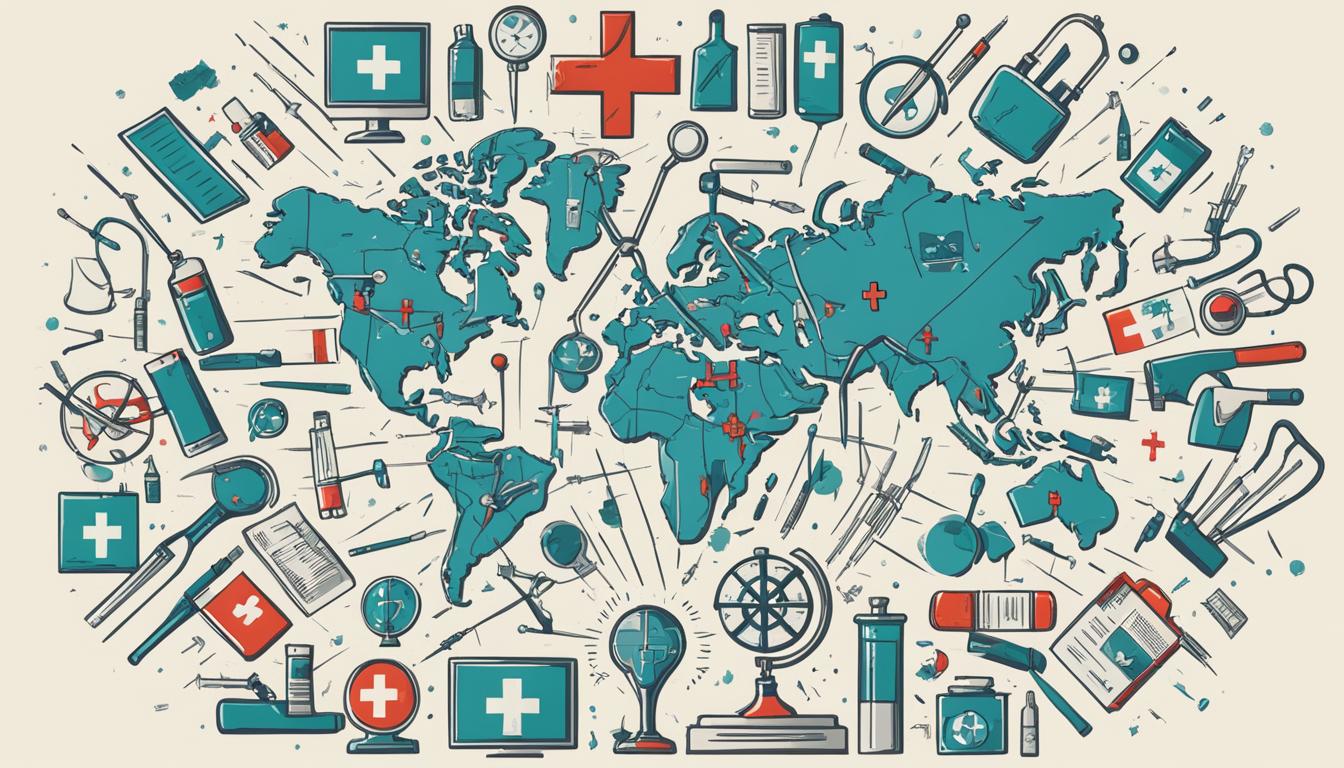The World Health Organization (WHO) recognizes the critical importance of disease prevention and control in improving global health outcomes. Through its global health initiatives and collaborative efforts, the WHO strives to develop effective public health strategies that address the challenges of international disease control.
One of the key strategies developed by the WHO is the global strategy on infection prevention and control (IPC). This comprehensive strategy focuses on improving IPC at the national, subnational, and facility levels, with an emphasis on protecting health workers, ensuring patient safety, and combatting antimicrobial resistance. By implementing this strategy, the WHO aims to reduce healthcare-associated infections and limit the impact of infectious disease outbreaks by 2030.
Key Takeaways:
- Disease prevention and control play a crucial role in improving global health outcomes.
- The WHO has developed a global strategy on infection prevention and control to address international disease control efforts.
- The strategy focuses on protecting health workers, ensuring patient safety, and combatting antimicrobial resistance.
- The WHO aims to reduce healthcare-associated infections and limit the impact of infectious disease outbreaks by 2030.
- Implementing comprehensive disease prevention measures is essential for shaping global health and promoting the well-being of future generations.
Country-Specific Disease Control Programs
Each country develops its own tailored disease control programs to address specific needs and utilize available resources. These programs encompass a range of strategies aimed at preventing, monitoring, and controlling diseases within their borders.
One key component of country-specific disease control programs is the implementation of global health surveillance systems. These systems play a crucial role in monitoring and tracking the spread of diseases, enabling timely responses and interventions.
Comprehensive disease prevention strategies form another essential aspect of these programs. Countries employ various measures to prevent the occurrence and spread of diseases. Some examples include:
- Conducting vaccination campaigns to protect populations against infectious diseases.
- Implementing health education initiatives to raise awareness about disease prevention and promote healthy behaviors.
- Enforcing vector control measures to minimize the transmission of diseases carried by vectors such as mosquitoes and ticks.
- Ensuring access to quality healthcare services for timely diagnosis, treatment, and preventive care.
By combining these approaches and tailoring them to their unique circumstances, countries strive to establish effective disease control programs that address the specific health challenges they face.
Challenges and Achievements in Country-Specific Disease Control Programs
“Our country’s disease control program has made significant progress in reducing the burden of infectious diseases. By implementing comprehensive prevention strategies and improving our disease surveillance systems, we have seen remarkable improvements in health outcomes.”
| Country | Achievements | Challenges |
|---|---|---|
| Country A | Successfully reduced malaria cases by 50% through vector control measures. | Limited resources for maintaining sustained prevention efforts. |
| Country B | Implemented nationwide vaccination campaigns, leading to a significant decline in vaccine-preventable diseases. | Ensuring equitable access to healthcare services in remote regions. |
| Country C | Established a robust disease surveillance system to detect outbreaks early and prevent their spread. | Building capacity to respond to emerging infectious diseases. |
The table above highlights some achievements and challenges faced by different countries in their disease control programs. Each country’s unique circumstances necessitate tailored approaches and ongoing efforts to overcome challenges and achieve improved health outcomes.
International Collaboration for Disease Prevention
In the global effort to prevent and control diseases, international collaboration is crucial. Through collective action and cooperation, countries can combine their resources, expertise, and knowledge to address common health challenges and mitigate the spread of diseases across borders. International health policies and initiatives play a significant role in fostering collaboration and coordinating global disease control efforts.
One notable international initiative is the Global Health Security Agenda (GHSA). The GHSA aims to strengthen global disease surveillance, response capabilities, and research collaborations to prevent, detect, and respond to infectious disease threats. It provides a platform for countries to exchange information, share best practices, and align their efforts towards collective health security.

The Impact of International Collaboration
International collaboration in disease prevention has yielded numerous benefits. By working together, countries can pool their resources and expertise to enhance disease surveillance and response systems, ultimately improving global health outcomes. Collaboration facilitates the sharing of information and best practices, allowing countries to learn from each other’s successes and challenges.
“International collaboration is vital in addressing global health challenges. By sharing information, resources, and expertise, countries can strengthen their disease prevention and control efforts, leading to improved health outcomes worldwide.” – Dr. Rebecca Johnson, Global Health Expert
Examples of International Collaborative Efforts
International collaboration in disease prevention is evident in various global health initiatives. One such initiative is the joint efforts of the World Health Organization (WHO) and its member states to combat infectious diseases through coordinated surveillance, rapid response systems, and capacity building.
Additionally, international organizations like the Centers for Disease Control and Prevention (CDC) and the World Bank work closely with countries to support national disease control programs and strengthen health systems. These collaborations facilitate the transfer of knowledge and resources, empowering countries to implement effective disease prevention strategies.
The Benefits of Cross-Border Information Sharing
A key aspect of international collaboration is the exchange of information between countries. Timely and accurate information sharing allows for early detection and response to disease outbreaks, helping to prevent their escalation. This collaboration also enables the identification of emerging global health threats and facilitates the development of targeted interventions.
| Benefits of International Collaboration in Disease Prevention | Examples |
|---|---|
| Enhanced disease surveillance | Sharing of real-time surveillance data through platforms such as the Global Outbreak Alert and Response Network (GOARN). |
| Improved response capabilities | Joint training exercises and simulations to test response readiness and identify areas for improvement. |
| Research collaborations | Pooling of resources and expertise to accelerate the development of vaccines, treatments, and diagnostics. |
| Capacity building | Technical assistance and knowledge transfer to support the implementation of effective disease control measures. |
Lessons Learned and Future Challenges
Over the past 15 years, global health strategies have undergone significant evolution and adaptation in response to emerging challenges. Lessons learned from previous efforts have proven invaluable in shaping new approaches to disease control around the world.
One of the key takeaways from these lessons is the importance of a proactive and prepared healthcare system. The global response to the COVID-19 pandemic revealed the critical need for strong healthcare infrastructure, efficient coordination, and rapid response capabilities. Future global health strategies must prioritize these aspects to effectively prevent and control disease outbreaks.
Lessons Learned:
- Early detection and rapid response: The COVID-19 pandemic highlighted the need for swift and accurate disease detection, as well as a coordinated international response. Countries that implemented robust testing, contact tracing, and isolation measures early on were able to effectively contain the spread of the virus.
- Health education and public awareness: Community engagement and education played a crucial role in controlling the spread of diseases. Empowering individuals with accurate information about prevention measures and effective hygiene practices helped minimize transmission rates.
- Collaboration and information sharing: International collaboration and data sharing among healthcare organizations, governments, and researchers facilitated a more comprehensive understanding of the virus and accelerated the development of vaccines and treatments.
In order to address future challenges in global health, it is essential to identify and confront the pressing issues that lie ahead. Several challenges are expected to shape the landscape of disease prevention and control:
Future Challenges:
- Climate change and its impact on health: Rising global temperatures and changing climate patterns are anticipated to lead to the increased prevalence of vector-borne diseases, food and waterborne illnesses, and extreme weather events that can contribute to the spread of infections.
- Rapid urbanization and health disparities: Urbanization poses unique challenges in healthcare access and disease control. Rapidly growing cities need adequate infrastructure, healthcare services, and public health policies to address increased population density and prevent disease outbreaks.
- Antimicrobial resistance: The misuse and overuse of antibiotics have led to the emergence of antimicrobial resistance, rendering previously effective drugs ineffective against infections. This poses a significant threat to global health, as common infections could become untreatable in the future.
Effectively tackling these challenges requires continued innovation, collaboration, and investment in global health strategies. Governments, international organizations, healthcare providers, and researchers must work together to develop and implement comprehensive disease prevention measures.
Disease Prevention Wrap Up
Disease prevention and control are pivotal aspects of global health. To effectively tackle the global burden of diseases, it is crucial to adopt a multifaceted approach that combines national and international efforts.
By developing and implementing global strategies for disease prevention and control, we can shape the future of global health outcomes. These strategies must be complemented with country-specific programs that ensure tailored solutions to address unique healthcare challenges.
Collaboration among nations plays a vital role in promoting global health. By sharing information, resources, and expertise, we can collectively work towards controlling diseases and safeguarding the well-being and safety of future generations.
Investing in effective disease prevention measures and adopting comprehensive strategies is key to achieving our shared goal of a world where diseases are controlled, outbreaks are limited, and global health takes precedence. Let us continue prioritizing disease prevention and control, ensuring a healthier and safer future for all.
Learn More About International Travel Nursing
What are global strategies for disease prevention and control?
Global strategies for disease prevention and control are comprehensive plans developed by international organizations, such as the World Health Organization, to improve infection prevention and control at various levels. These strategies prioritize health worker protection, patient safety, and combating antimicrobial resistance, with clear objectives and targets for reducing healthcare-associated infections and limiting infectious disease outbreaks by 2030.
What are country-specific disease control programs?
Country-specific disease control programs are initiatives implemented by individual countries to address their specific disease prevention needs and resources. These programs often include global health surveillance systems that monitor and track the spread of diseases. They also encompass comprehensive disease prevention strategies, such as vaccination campaigns, health education initiatives, vector control measures, and increased access to healthcare services.
How does international collaboration contribute to disease prevention?
International collaboration plays a vital role in disease prevention efforts. Through international health policies and initiatives, such as the Global Health Security Agenda, countries work together to strengthen global disease surveillance, response capabilities, and research collaborations. This collaboration involves sharing information, resources, and expertise to address common health challenges and prevent the spread of diseases across borders.
What lessons have been learned from previous global health strategies?
Over the past 15 years, global health strategies have evolved and adapted to address emerging challenges. Lessons learned from previous efforts have led to new approaches to disease control. These lessons emphasize the importance of continued innovation, collaboration, and investment in global health strategies. They also highlight the need to address future challenges, such as climate change, rapid urbanization, and the emergence of antimicrobial resistance.
What are the future challenges in disease prevention?
The future challenges in disease prevention include climate change, rapid urbanization, and the emergence of antimicrobial resistance. These obstacles pose significant threats to global health outcomes. To effectively tackle these challenges, continued innovation, collaboration, and investment in global health strategies are essential.
Why are global strategies for disease prevention and control important?
Global strategies for disease prevention and control are important as they shape global health outcomes, prevent the spread of diseases, and promote the well-being and safety of future generations. By investing in effective disease prevention measures and adopting comprehensive strategies, we can work towards a world where diseases are controlled, outbreaks are limited, and global health is prioritized.




